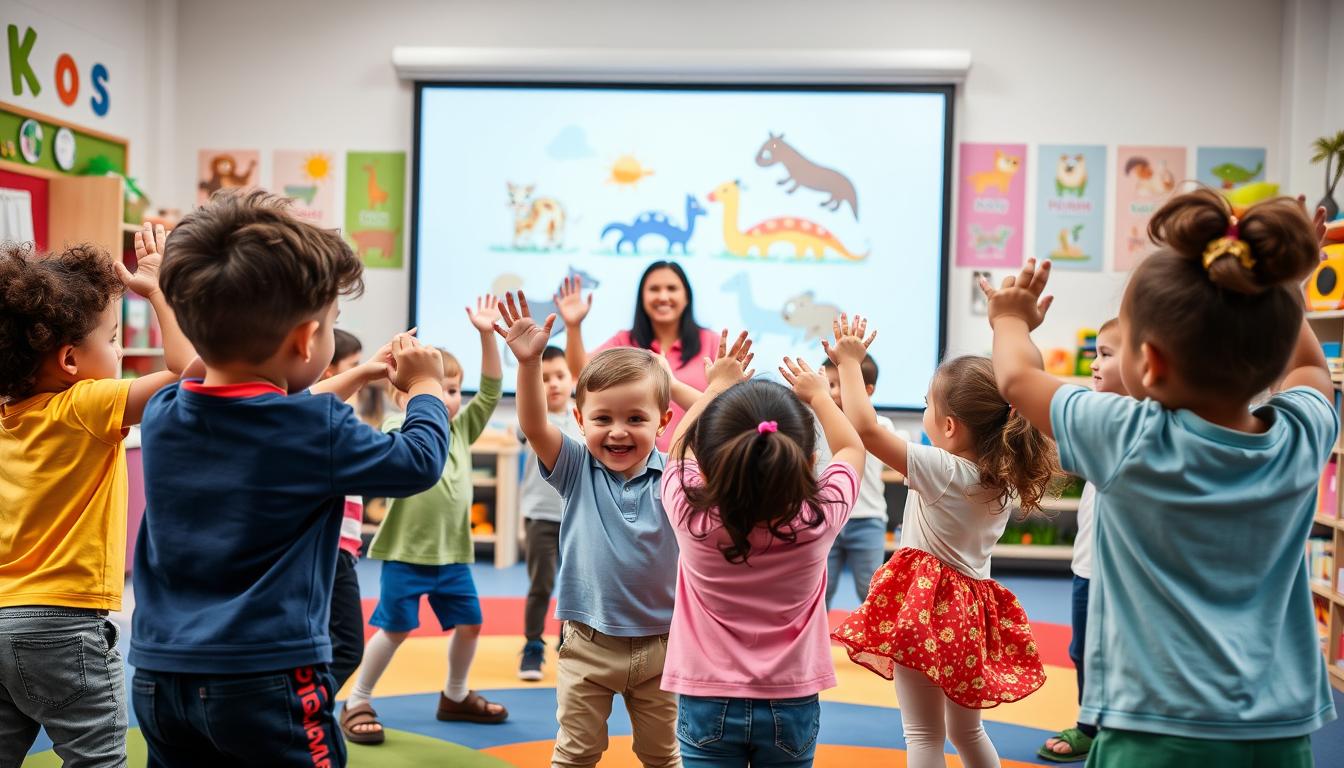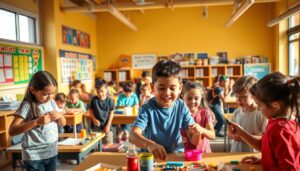Action Songs for Preschoolers
Picture a classroom buzzing with giggles as tiny feet stomp to a beat. A teacher starts singing, “If you’re happy and you know it…” and suddenly, little hands clap, shoulders shake, and bodies wiggle in unison. This joyful chaos isn’t just playtime—it’s learning in motion.
Preschoolers thrive when music and movement collide. These interactive tunes do more than burn energy—they build coordination, balance, and body awareness. Research shows rhythmic activities strengthen neural connections tied to reading and math skills later in life.
Families and educators love how simple lyrics paired with jumping or spinning turn lessons into adventures. Whether mimicking animals or touching body parts, kids absorb concepts naturally. Best of all? These moments create bonds through shared laughter and creativity.
Key Takeaways
- Combine music with physical play to boost motor skills and cognitive growth
- Use rhythmic activities to improve focus and make learning memorable
- Support early literacy and math readiness through patterned movements
- Strengthen family connections with shared musical experiences
- Adapt songs for transitions, brain breaks, or skill-building moments
The Benefits of Action Songs for Preschoolers
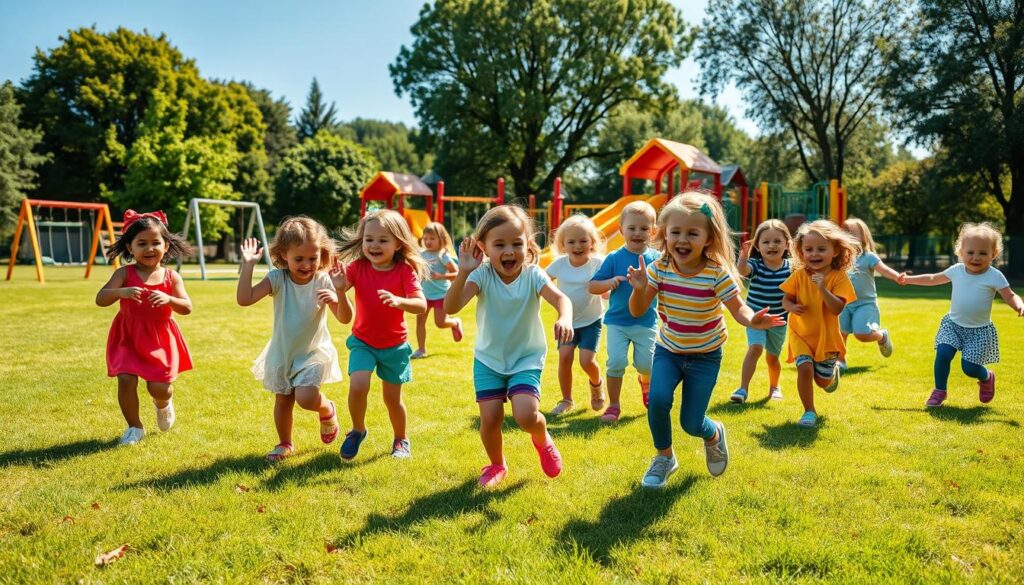
Imagine tiny hands clapping in rhythm while little legs practice hopping. Music becomes a secret superpower here, helping kids grow stronger and more aware of their bodies. Through playful melodies, they build coordination and balance without even realizing they’re learning.
Enhancing Listening and Movement Skills
Musical cues turn listening skills into a game. When directions like “touch your toes” or “spin slowly” pair with beats, children learn to connect sounds with actions. This boosts their ability to follow instructions while improving motor skills through jumping or balancing.
Fingerplays and hand motions add another layer. Tracing shapes in the air or tapping rhythms helps develop precise movements needed for writing. Kids also gain body awareness as they learn spatial relationships—understanding up vs. down or fast vs. slow through movement.
Boosting Social and Cognitive Development
Group singing sessions become teamwork practice. Children take turns leading motions and mirroring peers, building cooperation. Studies show these activities strengthen memory as kids remember lyrics and sequences—key foundations for early math concepts.
Language skills flourish too. Repeating phrases like “stomp like elephants” expands vocabulary while linking words to actions. Emotional growth happens naturally when music guides them to pause, speed up, or express feelings through creative moves.
Top Action Songs for Preschoolers That Spark Joy
Think of a room where tiny fingers trace circles in the air while voices chirp familiar lyrics. These musical adventures turn living rooms and classrooms into stages for growth through play. Let’s explore tunes that make learning feel like pure magic.
Classic Favorites: I’m a Little Teapot & Teddy Bear, Teddy Bear
“I’m a Little Teapot” transforms kids into kitchenware with style. Children round their arms like curved pottery, then snap elbows into spout positions. This favorite builds spatial awareness as they alternate between wide and narrow shapes.
The Teddy Bear rhyme takes youngsters through a full exercise routine. Little ones spin, reach for their toes, and mimic shoe-tying motions. Each verse adds new challenges, helping kids practice multi-step directions with fuzzy charm.
Modern Picks for Teletherapy and Home Play
Digital sessions love “Head, Shoulders, Knees and Toes” for its clear physical markers. Kids tap body parts while singing, reinforcing anatomy knowledge. Therapists often speed up the tempo to test coordination skills.
“The Wheels on the Bus” gets creative with hand motions. Little palms roll like spinning tires, while fingers flick like wiper blades. This crowd-pleaser encourages group participation and imaginative sound effects.
Try Freeze Dance for self-regulation practice. When music stops, children must halt mid-giggle – perfect for developing impulse control. Pair it with finger plays like Open, Shut Them to strengthen hand muscles through rhythmic opening and closing motions.
How to Integrate Action Songs into Daily Learning
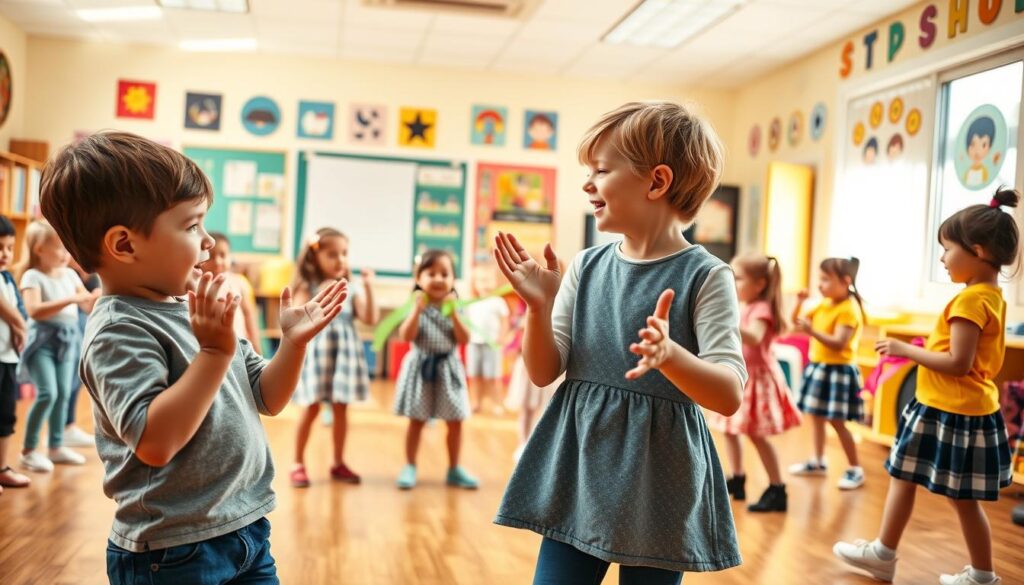
Picture parents and teachers exchanging knowing smiles as a familiar melody transforms restless energy into focused play. Music becomes a bridge between learning and living, turning ordinary moments into skill-building adventures kids adore.
Creative Ways to Use Music in the Classroom and at Home
Start mornings with rhythm. Teachers can kick off circle time using movement songs that help children shift from home to school mode. Clapping patterns or stomping games build teamwork while reinforcing routines.
Need to reset wiggly learners? Try two-minute music breaks between quiet activities. Simple tunes with spinning or jumping let kids recharge while practicing coordination. One preschool teacher shares: “When I play our ‘shake break’ song, even reluctant participants join in!”
| Setting | Activity | Benefit |
|---|---|---|
| Classroom Transitions | Cleanup song with marching steps | Teaches responsibility through rhythm |
| Outdoor Play | Nature scavenger hunt with movement cues | Combines exercise with sensory exploration |
| Family Car Rides | Seat-safe hand motions to favorite tunes | Makes travel time educational |
At home, bath time becomes splashy fun with water-themed rhymes. Parents can sing while demonstrating gentle motions – perfect for teaching body parts. Evening routines gain magic when twinkle songs accompany stretching exercises before bed.
Bad weather? No problem! High-energy movement songs turn living rooms into dance floors. Rotate leadership roles – let kids invent new motions to share. This approach builds confidence while keeping physical activity exciting.
Tips for Using Action Songs in Occupational Therapy Sessions
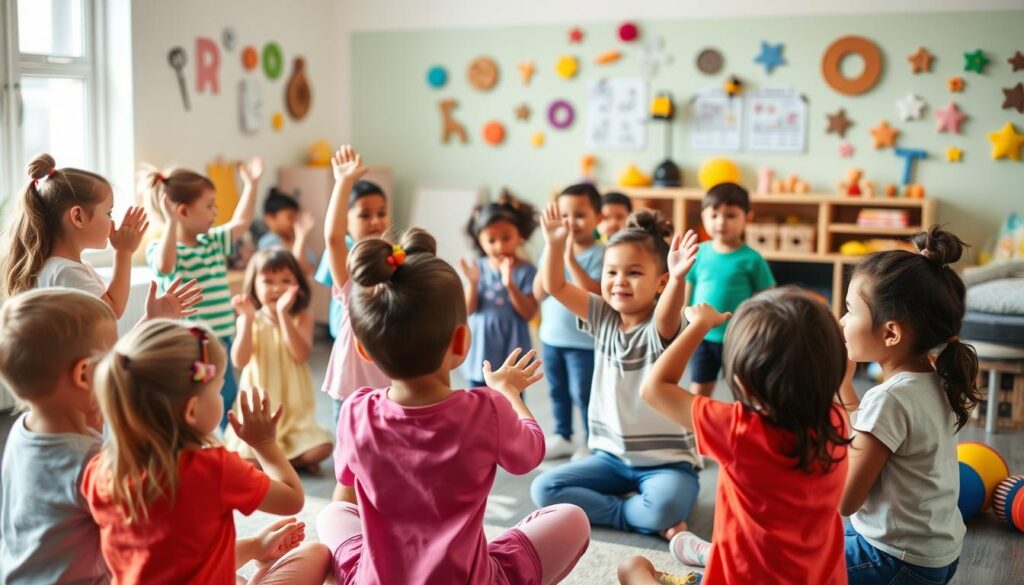
Therapists often see magic happen when a child’s favorite tune becomes a tool for growth. These musical strategies turn therapy goals into playful interactions that kids eagerly repeat. Let’s explore how rhythm and repetition create pathways for development.
Supporting Coordination and Motor Planning
Predictable patterns work wonders. Songs like One Little Finger build motor planning by asking kids to point to specific body parts. Break complex moves into smaller parts – touch your nose first, then your knees. This approach helps children master sequences gradually.
Incorporate heavy work movements for sensory needs. Add stomping during The Ants Go Marching or wall pushes between verses. One therapist notes: “Proprioceptive input through music helps kids feel grounded and ready to learn.”
Adapting Songs for Different Ages and Abilities
Slow down classics like Head, Shoulders, Knees and Toes for beginners. Speed up the tempo for older children needing coordination challenges. Use visual cues like hand shadows or flashcards if auditory instructions overwhelm.
- Simplify lyrics to focus on one skill per verse
- Create seated versions for wheelchair users
- Add resistance bands for strength-building during arm motions
Repetition remains key. Familiar structures let kids anticipate rhythms while practicing hand movements. Try different versions of the same song – some focusing on finger isolation, others on crossing midline. This flexibility keeps sessions fresh while targeting specific goals.
Conclusion
As little voices fade after one last twirl, the magic of musical play lingers. These lively rhythms do more than fill rooms with laughter—they plant seeds for lifelong learning. Through clapping, swaying, and reaching, children build brain connections while discovering how their bodies move through space.
Caregivers hold the key to unlocking these benefits. A daily dance break or fingerplay session strengthens coordination and family bonds. Printable resources and curated song lists make it simple to keep activities fresh. Many families find our YouTube playlist perfect for rainy days or quick transitions.
Watch eyes light up when music cues familiar motions. Little hands might tap knees during a counting rhyme or touch their nose in rhythm. These moments aren’t just fun—they’re building blocks for reading readiness and math skills.
Grab your Free Activity Pack below to extend the joy. Share your favorite movement ideas with other parents and educators. Together, we’re helping children grow stronger, smarter, and more confident—one clap at a time.
FAQ
How do movement-based tracks help preschoolers develop key skills?
What are some timeless movement tracks every child should learn?
Can these activities be adapted for children with different needs?
How can caregivers incorporate these tracks into daily routines?
Why are rhythm and coordination emphasized in early learning?
Are digital platforms effective for teaching movement-based tracks?

Adam Peter is a finance, travel, and automotive writer with over a decade of experience. He creates clear, practical content to help readers manage their money, explore the world with confidence, and make informed decisions about cars and travel gear. His work blends expert insight with real-world usefulness.

